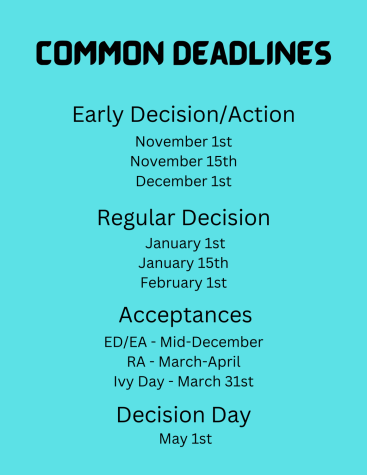The difference between college application deadlines
November 2, 2022
With college application deadlines approaching quickly, it’s important for seniors to understand the differences between application types
There are three application types: early decision (ED), early action (EA), and regular decision (RD). Early decision is binding, which means that you are entering an agreement with a school that if you’re accepted, you will attend their institution. Early action is non-binding, but allows a student to submit their application early. Regular decision is the most common application type, and is usually the final deadline for application submission. There are advantages and disadvantages to all application types.
“Early decision alleviates some of the stressors of choice,” senior Wesley Omerso said. “By applying into a binding application, ED gives you the most options for the school you’re wanting to go to. Whether that’s extra consideration for scholarship and financial need, or simply increasing your chances of getting in, ED has lots of benefits when you know where you want to go.”
Many students apply early decision to their top-choice schools because colleges reported higher acceptance rates for early decision applicants, compared with those who applied regular decision, according to US News.
Early decision is oftentimes a controversial application type because of the commitment it forces students to make.
“I typically do not encourage ED unless the school is highly competitive and it’s been a dream school for a student or family. I like to keep options open for
students,” post-secondary counselor Eddie Bobbitt said.
However, early decision is typically not completely binding. If a student is accepted into the school they applied early decision to, but the financial aid given by the school isn’t sufficient, backing out is an option. Colleges are more understanding in cases like these, according to US News.
If students are hesitant to submit a binding application, early action is another option for them. This application plan allows students to send out their applications earlier in order to get admissions decisions quicker than if they had applied regular decision.
“When you know what your top school is, waiting to hear back from them is so gut-wrenching,” Omerso said. “I know where I want to go, so applying early action to MIT made the most sense.”
There are other advantages to applying early action, such as being a part of a smaller application pool and having time to request transcripts and letters of recommendation before everyone else is rushing to get that done in time for the regular decision deadlines.
“Many schools require that you apply EA in order to be considered for merit scholarships,” Bobbitt said.

Both early application types allow students to receive acceptances or rejections before the regular deadlines, which can help them make decisions and prioritize their options.
However, many colleges do not offer early action or early decision applications. Highly selective colleges are more likely to offer these admissions options, according to US News. So even with all the advantages, there is nothing wrong with applying regular decision.
“[Regular decision] gives students more time to improve [their] resume or academic performance,” Bobbitt said.
Along with giving students more time to polish their application, applying regular decision doesn’t pit them against tougher competition and gives them a better chance to impress the admissions officers that are reading their profile.
It can be stressful with so many options when applying to colleges, so just remember to research the different application types every college has, and make the best choice for you and your application.


